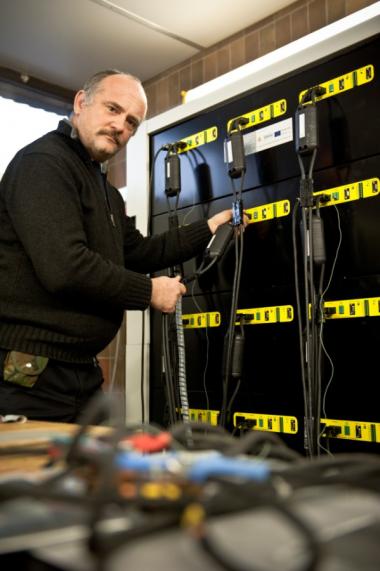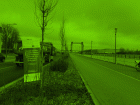
2013-10-14 – As a programme, EMOVO is both abstract and concrete, as it operates in several different areas: university research and the actual needs of businesses in the field of sustainable development in an urban setting. The project, financed by the European Regional Development Fund (ERDF) and the Brussels-Capital Region, operates from a laboratory based at the Erasmus University College Brussels (EhB). Focusing on environmental and energy technologies, it forms part of a project that is shared with VUB (Vrije Universiteit Brussel).
Businesses in Brussels can thus benefit from the know-how of university researchers and gain access to the EMOVO laboratories. A laboratory tour was also arranged for businesses in the capital in early 2013 by the Green Technologies Cluster of the Brussels Enterprise Agency (BEA). The goal of the project and the tours is to derive specific benefit, on the ground, from the capacities of these high-tech laboratories, as well as to stimulate research into concrete environmental issues.
Measuring the wind
To take a concrete application example, in the city and countryside alike there is wind, and that wind can be used to generate energy. But in an urban landscape, the constraints are more numerous than in the middle of the countryside. The city environment therefore needs to be carefully studied in order to set up a small wind turbine. The ‘wind lab’ can be used to evaluate the feasibility of a wind power project, estimate its long-term return, ensure that turbines are positioned optimally, and so on.
This kind of simulation is one of the possibilities offered at the laboratory located in the buildings of the Erasmus University College at Quai de l’Industrie in Anderlecht. A wind tunnel can be used for simulations on models and for measuring all the parameters that will need to be taken into account if the project is implemented. The measurements can then be viewed and analysed on computer monitors, making it possible to study wind trajectories, the aerodynamic properties of materials, the vibrations created and experienced by the turbines, and other factors.
Biomass emissions
Another laboratory focuses on a very different issue: analysing the particles emitted when incinerating biomass. Increasingly, Europe is recommending the use of organic matter, often recovered and recycled, to generate energy. While biomass incineration initiatives are multiplying, researchers are also investigating the emissions caused by this process.
Thanks to its laboratory, the EMOVO project makes it possible to perform real-time measurements, which is fairly unusual. Emissions into the urban atmosphere are then analysed and mapped. This represents a very useful tool in an urban environment on which ever greater demands are being placed.
Detection activities in the city
The detection programme also involves some rather surprising measurements of environmental parameters.
Voices and their reverberations, for instance, can have a significant impact in the city. Before combined voices become a real nuisance, it makes sense to analyse the phenomenon in the urban environment and with the materials of which that environment is composed, in order to see how sounds are propagated and above all how they can be abated.
Solar panels, which can be seen sprouting up on the roofs of buildings, warehouses and apartment blocks, can also be a source of nuisance. This is another feature that needs to be studied, particularly with regard to the level of irradiation created.
The effectiveness of batteries
Finally, the electric motor – an inevitable stage in the development of urban transport – also needs to undergo analysis. More specifically, the laboratory developed in connection with the EMOVO project has examined the issue of batteries and condensers. Tests have been performed on batteries in order to investigate their charge capacity and their storage of electrical energy.
In collaboration with partners from industry, the aim will be to find the battery that is best suited to companies’ needs. This applied research should be useful for cars, bicycles and public transport.
A laboratory for making things
In addition to scientific analysis, the project has also led to the creation of a ‘Fab Lab’ – a laboratory where businesses can go to make specific materials or create prototypes of their inventions. Fine laser-cutting facilities and 3D printers make it possible for creative users, including those of an artistic bent, to complete their projects successfully and in a very concrete form.
This scientific and pragmatic know-how is being put to work in Anderlecht, in modern buildings alongside the Canal, not far from the Chaussée de Mons and Square Albert Ier. These buildings belonging to the Erasmus University College are part of the University Association of Brussels, which also includes VUB.
More info: www.emovo.be
Jean-Pierre BORLOO



























